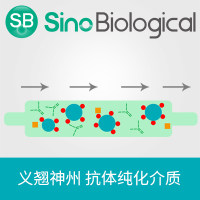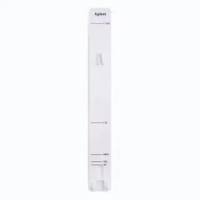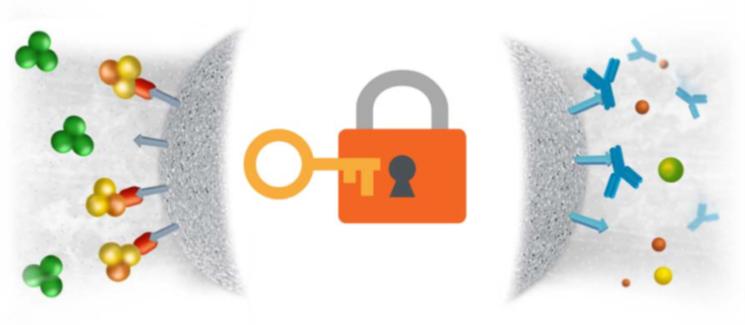亲和层析凝胶指南
互联网
GE Healthcare
Benzamidine Sepharose™ 6B is p-aminobenzamidine covalently
attached to Sepharose 6B by the epoxy coupling method.
p-Aminobenzamidine (PAB), is a synthetic inhibitor of trypsin-like
serine protease. Trypsin and trypsin-like serine proteases bind to
Benzamidine Sepharose 6B and can thus be used for purification and/
or removal of these substances. Trypsin, bovine thrombin, urokinase,
human enterokinase, acrosin, native plasminogen, kallikrein,
prekallikrein, collagenase and clostripain are some of the serine
proteases that have been purified on Benzamidine Sepharose 6B.
For recombinant purification, Benzamidine Sepharose 6B can be used
for removal of serine proteases such as thrombin and enterokinase
after cleavage of purification tags. Sample TextSepharose and Drop Design are trademarks of GE Healthcare companies. GE, imagination at work and GE monogram are
trademarks of General Electric Company.
Triton is a trademark of Union Carbide Chemicals and Plastics Co.
All goods and services are sold subject to the terms and conditions of sale of the company within GE Healthcare which
supplies them. GE Healthcare reserves the right, subject to any regulatory and contractual approval, if required, to make
changes in specifications and features shown herein, or discontinue the product described at any time without notice or
obligation. Contact your local GE Healthcare representative for the most current information.
© 2006 General Electric Company � All rights reserved.
GE Healthcare AB, a General Electric Company.
GE Healthcare Europe GmbH
Munzinger Strasse 5
D-79111 Freiburg
Germany
GE Healthcare UK Ltd.
Amersham Place
Little Chalfont
Buckinghamshire, HP7 9NA
UK
GE Healthcare Bio-Sciences Corp.
800 Centennial Avenue
P.O. Box 1327
Piscataway, NJ 08855-1327
USA
GE Healthcare Bio-Sciences KK
Sanken Bldg.
3-25-1, Hyakunincho
Shinjuku-ku, Tokyo 169-0073
Japan
www.gehealthcare.com/protein-purification
www.gehealthcare.com
GE Healthcare Bio-Sciences AB
Björkgatan 30
751 84 Uppsala
Sweden
71-7096-00 AE 07/2006
Elanders Östervåla 2006 12345
Elanders Östervåla 2006 12345
Elanders Östervåla 2006
Elanders Östervåla 2006
Elanders Östervåla 2006 12345
Elanders Östervåla 2006 12345
Elanders Östervåla 2006
Elanders Östervåla 2006
imagination at workTable 1. Medium characteristics.
Ligand density: 7 μmole p-aminobenzamidine/ml
drained media
Available capacitundefined: 13 mg trypsin/ml drained media
Bead structure: 6% agarose
Bead size range: 45�165 μm
Mean particle size: 90 μm
Max linear flow ratundefined~I_75_cm~Hh_at_25°C, HR 16/10 column,
5 cm bed height
pH stabilitundefined*~Kbr_~H~M~2~1~0Long_term~I_3�11
Short term: 2�13
Chemical stability: Stable to all commonly used aqueous
buffers
Physical stability: Negligible volume variation due to
changes in pH or ionic strength
~undefined The binding capacity was determinded in 50 mM Tris-HCI,
pH 8.0 containing 0.5 M NaCl.
~undefined_Linear_flow_rate_~L~Kbr_~H~M~2~1~0Volumetric_flow_rate_~Acm3~Hh~B~Kbr_~H~M~2~1~0column_cross~Fsectional_area_~Acm2~B~Kbr_~H~M~2~1~undefined*_The_ranges_given_are_estimates_based_on_our_knowledge_and~Kbr_~H~M~2~1~0experience._Please_note_the_following~I~Kbr_~H~M~2~1~0pH_stability~E_long_term_refers_to_the_pH_interval_where_the_medium~Kbr_~H~M~2~1~0is_stable_over_a_long_period_of_time_without_adverse_effects_on_its~Kbr_~H~M~2~1~0subsequent_chromatographic_performance.~Kbr_~H~M~2~1~0pH_stability~E_short_term_refers_to_the_pH_interval_for_regeneration~Kbr_~H~M~2~1~0and_cleaning.Contents~Kbr_~H~M~2~1~01._Preparing_the_medium_3~Kbr_~H~M~2~1~02._Packing_Sepharose_6B_medium_4~Kbr_~H~M~2~1~03._Using_an_adaptor_5~Kbr_~H~M~2~1~04._Binding_of_protein_5~Kbr_~H~M~2~1~05._Elution_of_protein_6~Kbr_~H~M~2~1~06._Regeneration_6~Kbr_~H~M~2~1~07._Cleaning_7~Kbr_~H~M~2~1~08._Storage_7~Kbr_~H~M~2~1~09._Ordering_Information_7~Kbr_~H~M~2~1~010._References_7~Kbr_~H~M~2~1~01._Preparing_the_medium~Kbr_~H~M~2~1~0Benzamidine_Sepharose_6B_is_supplied_pre~Fswollen_in_20~7~Kbr_~H~M~2~1~0ethanol._Prepare_a_slurry_by_decanting_the_ethanol_solution~Kbr_~H~M~2~1~0and_replacing_it_with_binding_buffer_in_a_ratio_of_75~7_settled~Kbr_~H~M~2~1~0media_to_25~7_buffer_before_packing._The_binding_buffer~Kbr_~H~M~2~1~0should_not_contain_agents_which_significantly_increase_the~Kbr_~H~M~2~1~0viscosity._The_column_may_be_equilibrated_with_viscous~Kbr_~H~M~2~1~0buffers_at_reduced_flow_rates_after_packing_is_completed.2._Packing_Sepharose_6B_medium~Kbr_~H~M~2~1~01._Equilibrate_all_material_to_the_temperature_at_which_the~Kbr_~H~M~2~1~0chromatography_will_be_performed.~Kbr_~H~M~2~1~02._De~Fgas_the_medium_slurry.~Kbr_~H~M~2~1~03._Eliminte_air_from_the_column_dead_spaces_by_flushing~Kbr_~H~M~2~1~0the_end_pieces_with_buffer._Make_sure_no_air_has_been~Kbr_~H~M~2~1~0trapped_under_the_column_net._Close_the_column_outlet~Kbr_~H~M~2~1~0with_a_few_centimeters_of_buffer_remaining_in_the~Kbr_~H~M~2~1~0column.~Kbr_~H~M~2~1~04._Pour_the_slurry_into_the_column_in_one_continuous~Kbr_~H~M~2~1~0motion._Pouring_the_slurry_down_a_glass_rod_held_against~Kbr_~H~M~2~1~0the_wall_of_the_column_will_minimize_the_introduction_of~Kbr_~H~M~2~1~0air_bubbles.~Kbr_~H~M~2~1~05._Immediately_fill_the_remainder_of_the_column_with~Kbr_~H~M~2~1~0buffer~E_mount_the_column_top_piece_onto_the_column_and~Kbr_~H~M~2~1~0connect_the_column_to_a_pump.~Kbr_~H~M~2~1~06._Open_the_bottom_outlet_of_the_column_and_set_the_pump~Kbr_~H~M~2~1~0to_run_at_the_desired_flow_rate._This_should_be_at_least~Kbr_~H~M~2~1~0133~7_of_the_flow_rate_to_be_used_during_subsequent~Kbr_~H~M~2~1~0chromatographic_procedures._However~E_the_maximum~Kbr_~H~M~2~1~0flow_rate~E_see_Table_1~E_is_typically_employed_during~Kbr_~H~M~2~1~0packing.~Kbr_~H~M~2~1~0Note~I_I_f_you_have_packed_at_the_maximum_linear_flow~Kbr_~H~M~2~1~0rate~E_do_not_exceed_75~7_of_this_in_subsequent~Kbr_~H~M~2~1~0chromatographic_procedures.~Kbr_~H~M~2~1~07._Maintain_the_packing_flow_rate_for_3_bed_volumes_after_a~Kbr_~H~M~2~1~0constant_bed_height_is_reached.~Kbr_~H~M~2~1~0For_detailed_desription_on_column_packing~E_refer_to_our~Kbr_~H~M~2~1~0Handbook_on_Affinity_Chromatography~E_Principles_and~Kbr_~H~M~2~1~0Methods_~A18~F1022~F29~B~E_which_can_be_downloaded_from~Kbr_~H~M~2~1~0~K~Hfont~M_~Kfont_color~L~4~522229c~4~Mwww.gehealthcare.com~Hprotein~Fpurification3.~K~Hfont~M__~Kfont~M_Using_an_adaptor~Kbr_~H~M~2~1~0Adaptors_should_be_fitted_as_follows~I~Kbr_~H~M~2~1~01._After_the_medium_has_been_packed_as_described_above~E~Kbr_~H~M~2~1~0close_the_column_outlet_and_remove_the_top_piece_from~Kbr_~H~M~2~1~0the_column._Carefully_fill_the_rest_of_the_column_with~Kbr_~H~M~2~1~0buffer_to_form_an_upward_meniscus_at_the_top.~Kbr_~H~M~2~1~02._Insert_the_adaptor_at_an_angle_into_the_column~E_ensuring~Kbr_~H~M~2~1~0that_no_air_is_trapped_under_the_net.~Kbr_~H~M~2~1~03._Make_all_tubing_connections_at_this_stage._There_must_be~Kbr_~H~M~2~1~0a_bubble~Ffree_liquid_connection_between_the_column_and~Kbr_~H~M~2~1~0the_bump~E_and_column_and_the_sample_application_valve.~Kbr_~H~M~2~1~04._Slide_the_plunger_slowly_down_the_column_so_that_the_air~Kbr_~H~M~2~1~0above_the_net_and_in_the_capillary_tubings_is_displaced_by~Kbr_~H~M~2~1~0eluent._Valves_on_the_inlet_side_of_the_column_should_be~Kbr_~H~M~2~1~0turned_in_all_directions_during_this_procedure_to_ensure~Kbr_~H~M~2~1~0that_air_is_removed.~Kbr_~H~M~2~1~05._Lock_the_adaptor_in_position_on_the_medium_surface~E~Kbr_~H~M~2~1~0open_the_column_outlet_and_start_the_eluent_flow._Pass~Kbr_~H~M~2~1~0eluent_through_the_column_at_the_packing_flow_rate_until~Kbr_~H~M~2~1~0the_medium_bed_is_stable._Re~Fposition_the_adaptor_on_the~Kbr_~H~M~2~1~0medium_surface_as_necessary.~Kbr_~H~M~2~1~0The_column_is_now_equilibrated_and_ready_for_use.~Kbr_~H~M~2~1~04._Binding_of_protein~Kbr_~H~M~2~1~0A_suitable_binding_buffer_is_50_mM_Tris~FHCl~E_pH_8.0_containing~Kbr_~H~M~2~1~00.5_M_NaCl._Good_results_are_obtained_at_room_temperature~Kbr_~H~M~2~1~0although_the_optimal_temperature_for_binding_is_4°C.
After the sample has been loaded, wash the medium with
binding buffer until the baseline is stable.5. Elution of protein
Bound substances can be eluted specifically or nonspecifically.
To elute bound substances specifically, a
competing agent such as p-aminobenzamidine can be used.
Competitive elution buffer:
20 mM p-aminobenzamidine in binding buffer.
Several methods may be used for non-specific elution of
bound sucstances:
• A change in ionic strenght alters the degree of ionization
of the charged groups at the binding site. Elution is
normally complete at salt concentrations of 1 M or less of
NaCl. Either step or continuous gradients may be used.
• A change in pH alters the degree of ionization of the
charged groups at the binding. Either step or continuous
gradients may be used.
• Reduction of the polarity of the elution buffer byaddition
of dioxane (up to 10%) or ethylene glycol (up to 50%)
may be used for elution of bound substances.
• Use of deforming agents like urea or guanidine
hydrochloride is an alternative for elution of bound
substances.
6. Regeneration
Depending of the nature of the sample, Benzamidine
Sepharose 6B may be regenerated for re-use by washing
the medium with 2�3 bed volumes of alternating high pH
(0.1 M Tris-HCl + 0.5 M NaCl, pH 8.5) and low pH (0.1 M sodium
acetate + 0.5 M NaCl, pH 4.5) buffers. This cycle should be
repeated 3 times followed by re-equilibration with 3�5 bed
volumes of binding buffer.
If detergent or denaturing agents have been used during chromatography,
these can also be used in the washing buffer.7. Cleaning
In some applications, substances like denaturated proteins
or lipids do not elute in the regeneration procedure. These
can be removed by washing the column with a detergent
solution, e.g. 0.1% Triton X-100 at 37°C for one minute.
Re-equilibrate immediately with at least 5 bed volumes of
binding buffer.
8. Storage
Benzamidine Sepharose 6B should be stored at 4�8°C in
the presence of a suitable bacteriostatic agent, e.g. 20%
ethanol, at neutral pH.
9. Ordering Information
Product Pack size Code No.
Benzamidine Sepharose 6B 25 ml 17-0568-01
10. References
1. Purification and characterization of a trypsin-like serine
proteinase from rat brain slices that degrades laminin
and type IV collagen and stimulates protease-activated
receptor-2. J. Neurochem. (2000), 74(4), 1731�1738,
Sawada, K. et al.
2. Purification of mast cell proteases from murine skin.
Exp. Dermatol. (1999), 8(5), 413�418, Algermissen, B. et al.
3. Purification of rabbit liver aldehyde oxidase by affinity
chromatography on benzamidine Sepharose 6B.
J. Chromatogr. (1989), 475 363-72, Stell, J. G. P. et al.
4. The Crystal Structure of a T Cell Receptor in Complex
with Peptide and MHC Class II. Science 1999 December 3;
286: 1913�1921. Reinherz, Ellis L. et al.









